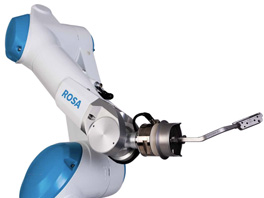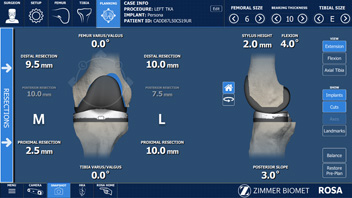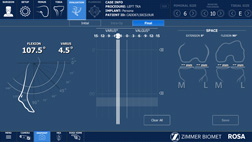
The
development of technology has greatly changed our way of life. In addition to
providing convenience to the general public, it also offers more precise and
minimally invasive medical procedures. Patients suffering from degenerative
knee joints may have heard of total knee replacement surgery, which involves
removing the damaged surfaces of the knee joint, replacing them with metal
implants, and inserting durable polymer cushions to restore the original
functionality of the knee joint. However, each person's knee joint is unique,
including factors such as the angle of varus and valgus, degree of wear, and
the mechanical distribution of forces on the knee cap. In addition to selecting
implants of the appropriate size and material, it is also important to
customize the implantation method to each individual. The ROSA robotic
arm-assisted joint replacement surgery is designed to create a personalized
implantation method for each patient. In traditional knee replacement
procedures, surgeons use instruments to assist in positioning and measuring the
bone to be removed. This can lead to larger incisions, longer recovery times,
and more tissue damage and pain. However, with the ROSA robotic arm-assisted
approach, top-notch optical lenses are used for precise positioning, allowing
real-time tracking of the patient's 3D spatial position. With the assistance of
a precision mechanical arm manufactured in Switzerland, surgeons can achieve
any desired rotation angle and depth, enabling them to accurately calculate and
remove the affected joint surfaces.

Furthermore, the new generation of process
design significantly reduces surgery time and minimizes the potential for
infections. Before customized surgery, it is necessary to understand the bone
structure of each patient. By utilizing 3D reconstruction algorithms, a
realistic bone model of the patient can be created using only two X-rays. This
helps surgeons plan the surgery and adjust the size, placement, and orientation
of the implants. By avoiding the need for CT scans for 3D bone modeling, the
radiation absorption is greatly reduced.

During
the surgery, in addition to providing a 3D bone model, the ROSA robotic
arm-assisted joint replacement surgery also includes a real-time intuitive soft
tissue balancing system. This system quantifies the surgeon's assessment of
ligament tension, continuously recording data before, during, and after the
procedure. Only the necessary tissues are removed, ensuring the preservation of
healthy tissues that do not need to be removed. This assistance helps the
surgeon precisely plan how to balance soft tissue preservation and bone
conservation, while reducing unnecessary postoperative pain for patients.

The
robotic arm-assisted joint replacement surgery provides orthopedic surgeons
with a more precise and reassuring surgical approach. Compared to traditional
surgery, it preserves more healthy tissues within the joint, allowing for a
more comfortable and faster recovery to return to the patient's original daily
life. However, it is important to note that this surgery is not suitable for
all patients, and a detailed diagnosis and evaluation by a specialized
orthopedist is still required before the procedure.